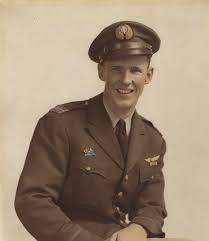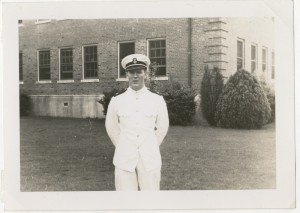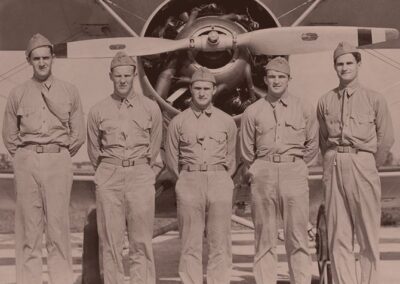
Photo Gallery
Fritz E. Wolf
Fritz E. Wolf was born in Shawano, Wisconsin on February 8, 1916. He attended Shawano High School where he excelled in leadership, character, and athletics. He graduated from High School in 1933. During that year he was on the football team that was conference champions and on the basketball team that went to the state playoffs.
Fritz received a basketball scholarship from Carroll College in Waukesha but interestingly, he never played a basketball game for the school. Instead, he was an all-conference fullback for 3 straight years. During that time Carroll only lost one football game. He graduated in 1938 with a Business Administration degree. He had the opportunity to try out with the Green Bay Packers but missed the tryout due to an appendicitis attack. About that time, he realized that if he was ever going to fly, that was the time.
He enlisted in The United States Navy in 1939 and upon completing flight training in 1940, he received his wings of gold and a commission as an Ensign. He was assigned to the USS Saratoga as a dive-bomber pilot. During his time at San Diego Naval Base, he was picked as one of the fliers to perform in “Dive Bomber”, a picture portraying Uncle Sam’s dive-bomber pilots before the war. In the summer of 1941 Fritz resigned his commission to join the American Volunteer Group (AVG) Flying Tigers. Like a lot of other pilots, he was looking for a little more excitement.
Fritz sailed in the first contingent of AVG pilots from San Francisco on July 6, 1941 aboard the Jaegersfontein. Fritz’s passport read agriculture student. The AVG arrived at Taungoo, Burma sometime in September of that year. His first task was getting the P-40 aircraft ready for combat, after a month they spent all their time learning how to fight the Japanese. This was accomplished through one-hour lectures given by Chennault and a lot of simulated dogfights.
On December 20, 1941, Fritz took part in the first AVG action near Kunming, China.
During that time he shot down two Mitsubishi bombers and assisted in downing a third before his ammunition ran out.
In February of 1942, somewhere near Rangoon, Burma, Fritz took part in a dog fight with 14 Japanese fighters. He was able to shoot down one before he had to turn tail and run. This victory was confirmed but combat records were lost.
On April 8, near Loiwing, China, he took part in another AVG action where he shot down two more Japanese fighters. Nine days later, near Magwee, China, Fritz was caught on the ground when the Japanese came over to bomb the airfield. This was the most terrifying time during his tour with the AVG. In Charlie Bond’s diary, he talked about this raid and how even Fritz Wolf was so scared. It was also during this time that Fritz witnessed the tragic death of John Fauth.
During his tour with the AVG, Fritz was subjected to a lot of Chinese illnesses. At one point they even had a coffin built awaiting his death. Because of his illnesses he spent a lot of time on the ground and was called on to handle operations. Chennault praised him for his administrative skills.
Fritz was honorably discharged on July 4, 1942 from the AVG. He had logged 220 hours of combat flying in the skies over Burma and China fighting the Japanese. The Chinese Government awarded him with the White Cloud Banner 6th Grade for heroism, China Air Force Wings 2 and 4 star and China War Memorial Decoration.
After returning to the US for some much-needed rest and fattening up (he lost 40lbs in China) he returned to the Navy with the rank of Lieutenant, Senior grade. He was assigned as a fighter pilot instructor at the Jacksonville Naval Air Station in Florida. Later he was transferred to Green Cove Springs, Florida to train with other replacement pilots that were preparing to be shipped overseas.
Fritz was the team’s section leader and after training, his team was sent to Great Lakes Navy Base for carrier qualifications. From there they were sent to Guam and arrived just after Christmas of 1944. Fritz and his team boarded the USS Hornet on January 8, 1945. Flying Grumman F6F Hellcats during his time in Fighter Squadron 11 (as known as the Sundowners) Fritz and the rest of the squadron struck Japanese targets in Hong Kong, Formosa, Hainan Island and French Indo China.
On one mission over Formosa, Fritz’s plane lost fuel pressure just after takeoff and he was forced to make a sea landing. After 3 hours of floating around in the ocean he was finally picked up by a destroyer. He later said that being plucked out of the water was worse than drowning. When the Hornet reached Ulithi, after the conclusion of its South China Sea action in early February of 1945, he was made Commanding Officer of the newly formed VBF-3 squadron aboard the USS Yorktown.
While serving as skipper of VBF-3, his squadron took part in strikes supporting the invasion of Iwo Jima. He also led the first historic naval carrier-based bombing attack against targets on mainland Japan. It was during this mission when he officially shot down his fifth plane making him an ace and was awarded the Distinguished Flying Cross for his heroics.
He was later transferred to Naval Auxiliary Air Station Brown Field, Chula Vista, California, as Executive Officer of the station. During this time, he applied to the regular Navy but was turned down for health reasons. He left the Navy in 1946 and went to work for the Wisconsin Aeronautics Commission. He stayed in the Naval Reserve until 1967, when he retired as a Commander.


